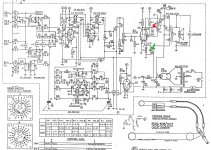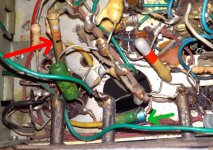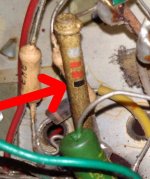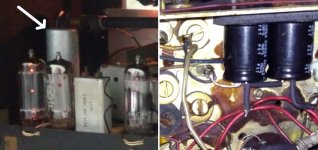Hi all,
after recent thread by @Elvee I remembered I need to change caps in my Vintage Philips Radio, bought by my dad in 70s. In the past I was told to replace Coupling capacitor. Radio is working somewhat.
Please see attached images. (1) Schematic showing coupling cap position and one elec. capacitor (2) Inside radio actual coupling capacitor shown with red arrow + Blue elec. cap shown (3) A mustard Cap which has tiny part broken at lead. also shown with red arrow.
My question are
1) what type I should use for coupling ? Voltages ? Value tolerance ? Manual says 8K2pf which I suppose is 8200pf. kindly confirm.
2) There is one electrolytic Blue Philips Cap hidden at bottom shown with green color. Should I change that ? What function it serves ? decoupling ?
3) Do I need to change Mustard cap (see pic attached) do they degrade over time ? (Almost 50 years). One has broken portion at lead.
thanks and regards
P.S. : pictures were taken prior to little cleaning.
after recent thread by @Elvee I remembered I need to change caps in my Vintage Philips Radio, bought by my dad in 70s. In the past I was told to replace Coupling capacitor. Radio is working somewhat.
Please see attached images. (1) Schematic showing coupling cap position and one elec. capacitor (2) Inside radio actual coupling capacitor shown with red arrow + Blue elec. cap shown (3) A mustard Cap which has tiny part broken at lead. also shown with red arrow.
My question are
1) what type I should use for coupling ? Voltages ? Value tolerance ? Manual says 8K2pf which I suppose is 8200pf. kindly confirm.
2) There is one electrolytic Blue Philips Cap hidden at bottom shown with green color. Should I change that ? What function it serves ? decoupling ?
3) Do I need to change Mustard cap (see pic attached) do they degrade over time ? (Almost 50 years). One has broken portion at lead.
thanks and regards
P.S. : pictures were taken prior to little cleaning.
Attachments
The tubular ceramic and "pinup" cap should be OK, and replaced only if they are a proven source of problems. The same with the mustard cap, which is a polyester film cap.
The blue E-cap is probably still OK, but I recommend replacing it anyway, as it is the most susceptible to degradation, due to age and heat
The blue E-cap is probably still OK, but I recommend replacing it anyway, as it is the most susceptible to degradation, due to age and heat
Thanks. I know without measuring one never knows. But since it is coupling cap. Do these type of capactiros leak ? What type of material are they ? (pic posted)The tubular ceramic and "pinup" cap should be OK, and replaced only if they are a proven source of problems. The same with the mustard cap, which is a polyester film cap.
The blue E-cap is probably still OK, but I recommend replacing it anyway, as it is the most susceptible to degradation, due to age and heat
As for elec. cap. it is parallel with resistor to ground. Dont know the function of the same. It is connected to pin2 of ECL82 valve.
Regards.
Attachments
Many old Philips radios, but fortunately not yours, have capacitors with paper dielectric sealed with a black, tar-like substance. On Dutch vintage radio forums they are known as teerbommen, tar bombs. Those are notorious because after many decades, they have usually absorbed some moisture. Their leakage current then increases a lot, as does their capacitance. Leakage in the AC coupling capacitor to the grid of the output valve makes its bias current increase, possibly enough to damage it and the output transformer.
You have capacitors with ceramic and polyester dielectrics that are likely to be fine.
You have capacitors with ceramic and polyester dielectrics that are likely to be fine.
Those dog bone caps are fine for the purpose.
As marcel has indicated most should fine except the electrolytics (should have a test at least). My 1957 Phillips had a large number of black tar caps and a tin multi section mains filter cap. Replaced the black tar caps with WIMA film caps and the main filter with the only electrolytic left - F&T dual section. Sound quality is great! Also considering they’re likely to discontinue analogue radio, that will be the last repair it will need.
As marcel has indicated most should fine except the electrolytics (should have a test at least). My 1957 Phillips had a large number of black tar caps and a tin multi section mains filter cap. Replaced the black tar caps with WIMA film caps and the main filter with the only electrolytic left - F&T dual section. Sound quality is great! Also considering they’re likely to discontinue analogue radio, that will be the last repair it will need.
I was thinking you could modulate a signal via coax into the front end. A system for mapping digital channels into radio via coax would be great. However RF design is another world i’m finding with digital clocking.Many valve radio enthusiasts make their own illegal very-low-power AM transmitters.
The capacitor in question is a tubular ceramic, normally very durable. It should be OK.Thanks. I know without measuring one never knows. But since it is coupling cap. Do these type of capactiros leak ? What type of material are they ? (pic posted)
As for elec. cap. it is parallel with resistor to ground. Dont know the function of the same. It is connected to pin2 of ECL82 valve.
Regards.
The E-cap bypasses the cathode resistor. Replace it with a slightly higher value, higher voltage modern type, 33or 47µF, 25V or 40V
Many old Philips radios, but fortunately not yours, have capacitors with paper dielectric sealed with a black, tar-like substance. On Dutch vintage radio forums they are known as teerbommen, tar bombs. Those are notorious because after many decades, they have usually absorbed some moisture. Their leakage current then increases a lot, as does their capacitance. Leakage in the AC coupling capacitor to the grid of the output valve makes its bias current increase, possibly enough to damage it and the output transformer.
I'm quite astonished to read about that tar bombs in Philips radios, as I've always been thinking Philips made vitualy all components by themselves or at one of their subsidiaries (e. g. Valvo/Hamburg made capacitors). Those tar bombs most probably are out of the Tropydur line by WIMA. Why should Philips have bought components from other sources? Did they learn to make their »mustards« later on?My 1957 Phillips had a large number of black tar caps and a tin multi section mains filter cap.
Anyway, WIMA's Tropydur are prone to fail indeed after decades, as their tar wrapping cracks, moisture gets in and degenerates the paper dielectric. Also be aware of WIMA's Durolit successors. They have plastic sheaths, but are paper capacitors anyway, and their sheaths also tends to crack, even if one doesn't see it.
Best regards!
They were made by Philips (and all the group). They were their consumer version of paper caps; the professional ones had an aluminum case, and rubber seals like bipolar E-caps, and they were practically hermetic, much more durable anyway.I'm quite astonished to read about that tar bombs in Philips radios, as I've always been thinking Philips made vitualy all components by themselves or at one of their subsidiaries (e. g. Valvo/Hamburg made capacitors). Those tar bombs most probably are out of the Tropydur line by WIMA. Why should Philips have bought components from other sources? Did they learn to make their »mustards« later on?
I think I still have an old MBLE databook somewhere, including the black tar caps
This is the datasheet of the "tar bomb":


And this is the "deluxe" version, with a surviving example:


And this is the "deluxe" version, with a surviving example:
Yes sir. The PS caps are already replaced. I understand the originality and aesthetics part of restoration. As original Dual 35+35uf aluminum can capacitor was near rectifier tube which used to get very hot, I fixed 2 new separate capacitors at bottom inside the chassis. Now orignal serves no purpose except authentic look.Hi, the PSU caps can be bad too. Here radio enthusiasts dislike the appearance of new PSU caps ("not original") so they build them into the casing of the quite large old original capacitor. Some even pot them with slow curing epoxy. Just a tip.
Dark brown stuff seen in right side of the picture is wax flowed in some parts which keeps some wires in close proximity of the metal chassis. So I didn't cleaned it.
regds.
Attachments
- Home
- Design & Build
- Parts
- Philips Valve radio capacitor replacement suggestion.




